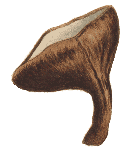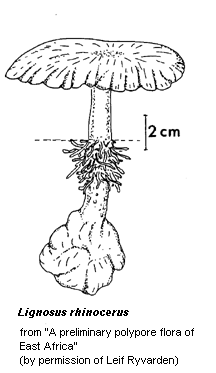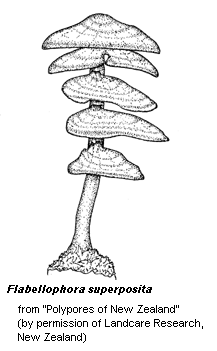Mycogeography
 Australia's
Gondwanan and Asian connections
Australia's
Gondwanan and Asian connections
A significant number of fungi found in Australian, while neither cosmopolitan
nor pantropical, still show a wide distribution - being also found in South
America, Asia or Africa. In some cases this reflects a Gondwanan origin, while
in others a later migration to or from Asia. In this section you will see some
examples of these fungi.
Species with an Australasian - South American distribution
Mycena interrupta is a saprotrophic mushroom, found on forest litter
in the damper areas of south-east Australia, New Caledonia, New Zealand and
Chile in Eucalyptus and Nothofagus forests. There are a number
of other Mycena species which show varying forms of Gondwanan distribution.
All the species of Mycena are small, saprotrophic mushrooms but not all
are Gondwanan. In fact the genus Mycena is found worldwide. However,
within Mycena there is considerable variety in the distributions of species.
Thus, there are numerous species confined to the temperate areas of Europe,
others are found only in Central America, others in both Europe and North America
and so on. Thus, a genus need not be restricted in distribution though certain
subgroups of species within the genus may be. Presumably a very ancient and
widespread parent "Mycena" split into separate lineages, in
Pangaean times, with the various lineages evolving separately in Gondwanan and
non-Gondwanan areas, but maintaining enough commonality to justify grouping
all into the same modern genus.
Podoserpula pusio ![]() ,
a basidiomycete with an unusual tiered growth form, is found in east and west
Australia, New Zealand and Venezuela. The underside of each layer is smooth
to slightly wrinkled - no gills, pores or spines.
,
a basidiomycete with an unusual tiered growth form, is found in east and west
Australia, New Zealand and Venezuela. The underside of each layer is smooth
to slightly wrinkled - no gills, pores or spines.
Various polypores have an Australasian-South American distribution. Aurantioporus
pulcherrimus (formerly Tyromyces pulcherrimus) occurs in Victoria,
Tasmania, New Zealand and southern Brazil. Laetiporus portentosus (formerly
known as Piptoporus portentosus) is quite common in the dry sclerophyll
forests and woodlands of the ACT but has a wider distribution in Australia and
is also found in New Zealand, Chile and Argentina. Similar patterns are shown
by Neolentiporus maculatissimus (formerly Piptoporus maculatissimus),
Ryvardenia cretacea (formerly Piptoporus cretaceus) and Ryvardenia
campyla (once known as Tyromyces campylus or Grifola Campyla).
The sheet-like but pimpled fruiting bodies of the corticioid species Hyphodontia
australis ![]() are fairly common in southern Australia. The original description, published
in 1879, was based on a specimen collected from Tasmania. Since then it has
also been found in New Zealand and southern Argentina.
are fairly common in southern Australia. The original description, published
in 1879, was based on a specimen collected from Tasmania. Since then it has
also been found in New Zealand and southern Argentina.
Species found in Australasia - Africa - South America
The polypore genus Phaeotrametes has just one species, Phaeotrametes decipiens. The genus is unusual in some of its microscopic features and not obviously closely related to any other polypore genus. Leif Ryvarden, an expert on the polypores of the world, thinks it to be an archaic genus and a "living fossil". It shows a Gondwanan distribution, being found in temperate Australia (both east and west), Brazil, Uruguay, Madagascar and the nearby east African mainland.
Another polypore, the sheet-like polypore Macrohyporia dictyopora is found in eastern Australia (from Queensland to Victoria), Argentina, Reunion Island and east Africa. The ascomycete Cookeina colensoi [www.hiddenforest.co.nz/fungi/class/ascom01.htm] is found in tropical Australia, New Zealand, Argentina and Madagascar.
Species of Australasia-Asia-Africa
Many species are found in Australasia and one or both of southern Asia and Africa. Some of these will probably be tropical Asian species which have migrated to northern Australia, others are likely to be of Gondwanan origin.
The saprotrophic polypore Microporus xanthopus is one of the commonest
fungi in tropical areas from Australia through to Africa, but is not found in
the American tropics. It can be found on rotting wood of numerous tree species
in the wet, forested areas. As a whole the genus Microporus is found
in Australia, many parts of Asia and tropical to south-temperate Africa.
The bolete Phlebopus marginatus is found in Australia, New Zealand,
Indonesia, Malaysia and Sri Lanka. You will see it under the older name, Phaeogyroporus
portentosus, in a number of field guides dealing with Australian fungi.
This species is very close to the African species Phlebopus sudanaicus
- and possibly identical. While the genus Phlebopus is found in South
America, the species Phlebopus marginatus is not found there.
 |
 |
Lignosus is a tropical polypore genus with four species. In Australia
Lignosus rhinocerus is found in Queensland. Outside Australia it occurs
in Papua New Guinea, Borneo, Philippines, Indonesia, Malaysia, Sri Lanka and
Vanuatu. Species of Lignosus are unusual for polypores because in each
case the fruiting body consists of a cap on a central stem (which occurs in
few polypore genera) and grows from a sclerotium in the ground (which is even
rarer), rather than from wood as is the case with most polypores. Another species
of Lignosus has been found in Papua New Guinea and Africa, and the remaining
two species are confined to Africa.
Another polypore, Flabellophora superposita, occurs in northern NSW,
Papua New Guinea, Borneo and Malaya and the usually bracket-like polypore Fomitopsis
lilacinogilva (once known as Trametes lilacinogilva) grows in Australia,
New Zealand, Papua New Guinea and South Africa. The leathery-textured, mushroom-like
fruiting bodies of Lentinus sajor-caju ![]() is found in Australia and through Asia to Africa, generally in the tropical
to sub-tropical parts of those areas. The cup-like fruiting bodies of Plectania
campylospora
is found in Australia and through Asia to Africa, generally in the tropical
to sub-tropical parts of those areas. The cup-like fruiting bodies of Plectania
campylospora ![]() (up to 5 centimetres in diameter) are found in Australia, New Zealand and parts
of southern Asia as far west as Sri Lanka.
(up to 5 centimetres in diameter) are found in Australia, New Zealand and parts
of southern Asia as far west as Sri Lanka.
![An Australian Government Initiative [logo]](/images/austgovt_brown_90px.gif)








